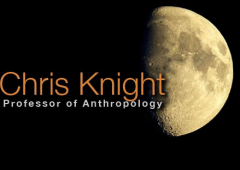[photopress:cartoon.png,full,alignleft]EVOLUTION
Do the origins of mankind’s success lie in a sex-strike by our female ancestors?
IT ALL began with cosmetics. What did? The human success story. How we came out of Africa about a hundred thousand years ago, beat up all our rival species and invented language, art and religion. And we were able to do all this because of make-up.
But cosmetics were just the starting point, according to the latest theory. Two other key ideas about human development suggest that menstruation lies behind our earliest ideas about gods and the supernatural, and that at some time in the not-so-distant evolutionary past — say 100,000 years ago — women went on a sex strike to force men to go hunting and bring back the meat.
The theory is the work of Dr Chris Knight of the University of East London and this week he is presenting a paper at a major conference at Edinburgh University on Evolution and Language.
“Many language researchers believe that myth and art were the result of language,” he says. “But that’s the wrong way round. You only need language if you already have an experience of myth.” And that is where cosmetics come in.
But to begin at the beginning, we all know that humans have bigger brains than any other primate, and also that human males are driven by a relentless urge to have sex with as many females as possible, Both of these facts present problems for our female ancestors. Babies’ increasing brain size meant that they had to come out of the womb sooner and so were around as helpless infants for longer. Mothers therefore needed more help but men were not much use because they were always looking out for someone else to impregnate.
Females’ first solution was to make sex available all the time The swellings and other signs of fertile periods that monkeys display disappeared in humans, so men never knew the best time for conception and stayed around longer.
But menstruation then became the give-away. The sign “fertile time coming” made a menstruating female more attractive to a male than one who was pregnant, or breast feeding. As the male helped provide food, a new mate would be a threat to the existing women and their resources. So at some point all the women in a tribe hit on a group deception. When one or two began to bleed they all marked themselves with blood-like make up. Now they all might be fertile too.
This was the first use of cosmetics and it is Knight’s claim that you can actually trace when this idea took off. The best supply of a blood-red pigment is a sort of red ochre rock. If you look in caves prior to 130,000 or so BC there is little sign of it, but then comes an “ochre explosion”, at a time when anatomically-modern humans were beginning to emerge in Africa. Some busy decorating was going on and sham menstruation was the cause.
The female solidarity that all this body painting created then provided a solution to a looming food crisis. The climate was changing and the women and children could no longer find enough food by foraging around the camp, so the men had to go hunting further away.
But how to make them go in the first place, and how to make sure they did not eat their kill on the way back? Here the female collective had their second brain wave — a sex strike. Instead of sex all the time the message now was: “No meat, no sex.” The scene was set for a female-driven cultural lift-off.
The women developed a series of rituals involving animals and yet more elaborate make up to signal what they wanted the men to do. Language grew up as part of that female conspiracy within these ritual groups.
“Many conventional language theories link it with male activity like hunting,” says Knight, “but the whole point about language is that it is a way of talking about an imaginary world outside space and time. You don’t need all the complexity of syntax and past and future tenses if you are dealing with the here and now. Gestures work pretty well. Language refers to the world of the imagination and that was what was going on with these sex-strike rituals.”
What tethers Knight’s scenario to the ground are the predictions his theory makes. The cosmetic link is one, others are the hunting and menstrual traditions among hunter-gatherer groups such as the Khoisan in South Africa, who have apparently arbitrary rules about when to hunt and have sex, and taboos about food and menstruation that make sense in terms of his model.
“If you found cave art paintings showing men and women copulating,” says Knight, “that would blow the theory out of the water because it says art is to do with the mythic realm. So far, however, we seem to be on the right track.”
Jerome Burne
